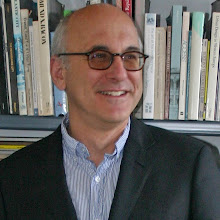 |
| Looking over Lake Hollywood on a rainy day and imagining a Red Line loop from Hollywood to Burbank, Glendale, and then along the Los Angeles River to Union Station. |
For about fifteen years now there has been a focused discourse in the design professions about infrastructure. Infrastructure, that dimension of urbanism that for more that half a century has been the almost exclusive domain of engineers. Infrastructure, the stuff of highways, sewers, high-tension electrical grids, fiber optic networks, etc. Infrastructure has become a fashionable pursuit of designers. A quick trip to an architectural book store such as William Stout in San Francisco or Hennessy and Ingalls in Los Angeles will unveil a plethora of magazines, books, and pamphlets, each extolling the opportunities of infrastructural urbanism. In these design manifestos, more often than not, infrastructure, often buried, is made manifest, and designed and writ large over the city landscape.
Infrastructural schemes for giant parks, buildings as landscape, or the ad-infinitum insect-like meta-structures self-constructing themselves on top of the topos are at once visions of the future and expressions of a desire by designers to re-engage city building beyond the four walls of an individual building or the fence-line of an open space or park. In an age of climate change, population explosion, dire poverty, fabulous wealth, and with more than half of the world's people now living in cities, designers want a piece of the extra large construction pie. The profusion of infrastructural drawings, schemes, and concepts connect the design of cities with the design professions who have largely, even today, been left out of the infrastructural decision-making tree.
I will admit to a bit of cynicism when I see many of the ideas that purport to show a designed-by- architects infrastructural future. Too often the extra-large scale of the ideas, the magical thinking with regard to materials and structure, the naivety with regard to any understanding of resource requirements, all combine to make it too easy to dismiss the visions as utopian, i.e. nowhere. Yet this impulse to describe a future, and do it in terms of a drawing or model, can not be totally discounted because aesthetics has the capacity to bring the challenges and optimism of progress towards a more livable city to the foreground, and allows even those of us with somewhat Luddite everyday tendencies to re-imagine for the better the place where we live.
Today, my freind Nevin and I took a hike in the rain, wind, and cold from the top of Beachwood Canyon to the Hollywood Sign. While the clouds were low and the atmosphere damp, nevertheless the views were long and wide below the gray cover. One could see all of the mountains through the mists for a distance of up to seventy miles. Below us sprawled all of greater Los Angeles; the spine of Wilshire, the clusters and concentrations of Hollywood, Glendale, Burbank, Downtown, Century City, and beyond were all visible. Our center for these panoramas of course was that great stretch of open space, Griffith Park and its wilderness surrounds. From its peak we could see and imagine the whole city at once. The rain in our faces only made the intensity of the moment more acute. We were standing at the navel point of Los Angeles infrastructural urbanism. At that moment a flash came into my head, an infrastructural snapping that while divorced from the parametric meanderings of advanced architecture and landscape urbanism logics, was nevertheless dependent upon their constructs and insights.
I imagined that the Metro Red Line subway did not terminate in North Hollywood. Rather, after its journey from Downtown to Hollywood, and then north along Lankershim Boulevard, the train turned east on Chandler Boulevard, an abandoned rail-right-of-way, and rolled on and into Burbank. Once in Burbank the train could turn north, again on existing heavily used rail roads, and head to Bob Hope Airport, or, turn south and link to Glendale running parallel to both San Fernando Road and the Los Angeles River. On this journey soon enough our subway crosses the Glendale Freeway and heads towards the confluence of the Los Angeles waterway with the Arroyo Seco. We pass Taylor Yards, the new Los Angeles State Historic Park, and the Cornfields, all subjects of planning studies that imagine redevelopment of historic rail yards into places of work, living, and play. Moving further south the trains curls home into Union Station, refinding its starting point and completing a grand Red Line loop; a loop that can be easily imagined from the roof of Griffith Park.
The completion of this infrastructural dream would hardly be inexpensive, but it has a type of material pragmatism that is approachable over the course of two or three or five decades. It ties together Downtown, Hollywood, Burbank and Glendale, along with numerous other communities, with some of the largest undertakings in the Los Angeles basin, such as the Los Angeles River Master Plan.
In many ways this is a modest proposal. While I am sure I am not the first person to imagine this, the impact of such a proposal, its ability to change the way we experience the urbanism of Los Angeles, the manner that completed infrastructure allows for intensification in new neighborhoods and conservation in older communities, is as big as any bloburb drawn or illustrated in a book. While one can be at first dismissive of designers that draw infrastructural visions that look unobtainable, the culture of the extra-large, as exemplified by the imagining of a giant Los Angeles loop below and at-grade, has the capacity to make even those of us who think from the ground up, and from the inside to the outside, conceive of neccessary ways to build and rebuild at giant increments of scale and scope previously unexplored and unimagined.

No comments:
Post a Comment